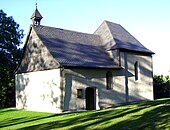Keffelke
Keffelke is a desolate, fallen place near Brilon , which was first mentioned in 1113. The place was mentioned in documents as Caphlicum and Kefflike. Keffelke consisted of ten farms. At times he belonged to the Assinghauser Grund . The remnant is the Keffelker Chapel , the individual courtyard next to it was built after the Second World War.
history
The place is in the eastern field of Brilons, about four kilometers from the town center. In the Middle Ages an important long-distance trade route ran here, leading from Bigge over the Borberg to Hilbringhausen and Keffelke to Marsberg. The name of the place was derived from a brook that rises nearby and shortly afterwards seeps into the mass limestone in a brook shrinkage. It means keffelke, the place on a slowly flowing body of water that disappears in a hollow . During its heyday, the village consisted of at least eleven farms, the existence of which is documented. They were inhabited by free and unfree or semi-free peasants.
Like many other places, the place fell victim to the great desolation process in the late Middle Ages . It appears to have been a gradual process. This began around 1300. In the period between 1400 and 1500, individual farms are still mentioned. The last farm seems to have perished at the time of the Thirty Years War . There are different theories about the reasons for leaving the place. The attraction of the city of Brilon was mentioned. Albert K. Hömberg has already contradicted the thesis of a planned amalgamation of several villages with the city of Brilon . One possible reason could be to do with lead mining. According to Wilfried Reininghaus, Keffelke, which was located in the middle of the mining area, could have been affected by considerable environmental damage. A farm initially remained and was recorded by Mercator on a map as Keffelich hoff in 1572 . It also appears in the treasury register of the Duchy of Westphalia from 1565.
The district of the village of Keffelke was quite large, it reached far to the south as far as the Hohen Eimberg near Willingen . In a contract between the county of Waldeck and the city of Brilon it was agreed that the residents of Keffelke were allowed to settle in Brilon. There is evidence that there was a clergyman in the village who found accommodation with the Brilon clergy . According to tradition, he was also the successor to vicar, but had the special title of chaplain.
Individual evidence
- ^ Wilfried Reininghaus: Mining cities in the Cologne Sauerland. In: City and Mining. Cologne, 2004 p. 56.
literature
- Gerhard Brökel: Past times. Edited by the Semper Idem History Society, p. 24.
- Heinz Günter Horn (Ed.): Theiss Archaeological Guide. Westphalia-Lippe. Stuttgart 2008, ISBN 978-3-8062-2218-0 , p. 57f.
- Heinrich Hülsbusch St. Antonius Chapel Ed. Propsteigemeinde Brilon
Coordinates: 51 ° 24 ′ 17.8 " N , 8 ° 37 ′ 30.6" E
